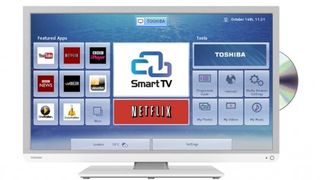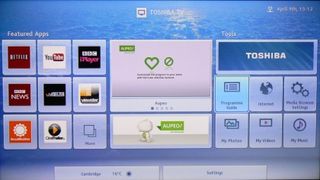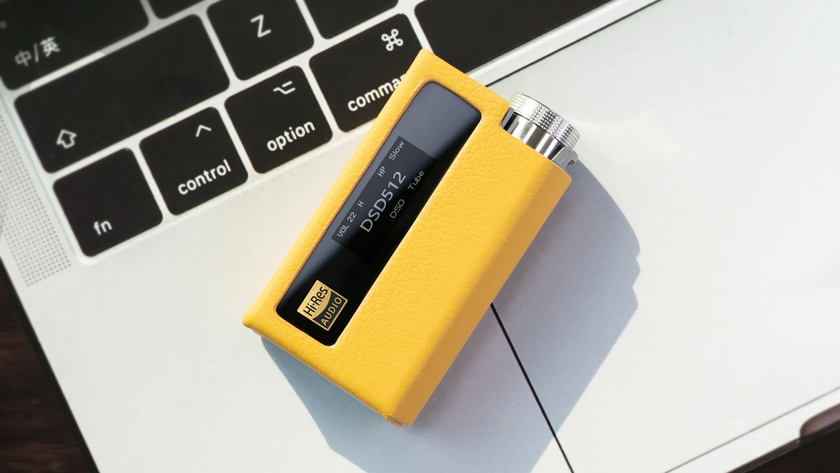TechRadar Verdict
This TV/DVD combi ticks most of the feature boxes sought after by the 'second room' TV market and the price looks right. But it doesn't exactly set the world alight with its AV performance.
Pros
- +
Good feature count
- +
Plenty of content options
- +
Pictures look sharp
- +
Aggressive price
Cons
- -
Limited viewing angle
- -
Dark colours look unnatural
- -
Some backlight clouding
- -
Limited catch up TV
Why you can trust TechRadar
In these increasingly complicated TV times, there's something refreshingly straightforward about Toshiba's 32D3454DB.
For rather than trying to push the envelope on new technologies like curved screens, Ultra HD resolutions and OLED, instead it just wants to give normal households a highly affordable and thoughtfully featured TV option for use in second rooms – kitchens, studies, bedrooms, conservatories and so on.
Actually, I guess its 32-inch screen just about qualifies it for main living room use in a few households. But with the vast majority of main TVs being sold these days weighing in at more than 40 inches, for most people the 32D3454DB will be very much second-room material.
So it's handy that the 32D3454DB carries such second room-friendly features as network streaming features and a built-in DVD player – features that instantly solve the usual second-room TV problem of how to easily access plenty of content.
Also on a second-room buyer's likely wish list will be affordability. And here again the 32D3454DB measures up with its aggressive sub-£350 asking price.

Design
While we Brits tend to err on the side of black or grey conservatism when picking a TV for the main living room, when it comes to second rooms we often become a bit more adventurous.
A fact Toshiba is embracing with the D34 series by offering both the white 32in version we're looking at here and a black alternative (the 32D3453DB).
For me the white version is just the job for bright environments like a kitchen or conservatory, while you might prefer the black option for studies and bedrooms. But the point is that you've got a choice.
Aside from the colour options, though, it must be said that there's nothing particularly exciting about the 32D3454DB's design. Its frame is relatively chunky by modern TV standards, and its shape is pretty much a straight rectangle. Its rear is unusually deep too, though of course there's a good excuse for this in the shape of the DVD player built into its rear right side.
DVD delight?
This DVD player is understandably pretty basic in specification, but then it doesn't need to do anything more than just play DVDs anyway given that 'smart' features are available elsewhere in the TV's OS.
Connections on the 32D3454DB are fair enough for a budget second-room TV, and are headed up by two HDMIs, a Scart (something more likely to still be used in a second-room environment), a USB input, an RF input delivering signals into a Freeview HD tuner, and both LAN and, impressively, integrated Wi-Fi network options.
The network ports support both DLNA streaming of photo, music or video files from PCs, as well as – remarkably for such a cheap set – access to Toshiba's Cloud TV online platform.

Online services
I should point out that this is not as full a version of Cloud TV as you get on higher-level Toshiba TVs; there are none of the usual recommendation 'avatars' or social media features for instance (though the latter aren't greatly missed in truth).
It's also true that Cloud TV continues to lag behind some rival online TV services when it comes to on-demand video support, as its YouTube, Viewster, Netflix, BBC iPlayer and BBC News apps are not joined by the ITV Player, Lovefilm/Amazon Prime, 4OD or Demand 5.
But come on – you can't expect the whole world and a cherry on top for under £350. Frankly getting any smart support at all on such a cheap 32-inch combi TV is a bonus.
Toshiba has a distinguished record of taking picture calibration seriously even at the relatively low end of its TV range. And this just about holds good for the 32D3454DB, as it offers such niceties as multiple backlight settings, a skin tone tweaker, the facility to adjust the gain of the RGB colour elements, a rather primitive but still worthwhile slider for adjusting the image's green and red balance, and an optional dynamic contrast system.
Noise reduction
You also get a noise reduction system, but this is a fairly basic effort by modern standards so I'd advise that you don't use it, at least when watching HD content and DVDs.
The specification of the 32D3454DB's screen is solid. Its native resolution is an HD Ready (rather than full HD) 1366x768, and although its panel is only a native 50Hz affair, its motion handling is bolstered by Toshiba's AMR 100 system, which uses processing to emulate 100Hz.
For the sake of completeness I should point out that the 32D3454DB does not support 3D playback. But I wouldn't have expected anything different given the set's focus - and anyway, 3D is pretty much a waste of time on a TV as small as 32 inches.
One final point of interest worth throwing in here is that the 32D3454DB's onscreen menu design suggests that it's been built using the same panel source (Turkish manufacturer Vestel) used by Finlux TVs.
John has been writing about home entertainment technology for more than two decades - an especially impressive feat considering he still claims to only be 35 years old (yeah, right). In that time he’s reviewed hundreds if not thousands of TVs, projectors and speakers, and spent frankly far too long sitting by himself in a dark room.

Google One AI Premium now includes one of my favourite AI tools for no extra cost, and it’s 50% off for students

Ever wish you had a tube amp with you everywhere for your headphones? Now you can with this switchable USB-C DAC

Newspaper printing across US hit after Lee Enterprises says “cybersecurity event” disrupted operations
Most Popular


